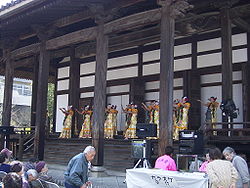
Gosho-ji
Encyclopedia

Buddhism
Buddhism is a religion and philosophy encompassing a variety of traditions, beliefs and practices, largely based on teachings attributed to Siddhartha Gautama, commonly known as the Buddha . The Buddha lived and taught in the northeastern Indian subcontinent some time between the 6th and 4th...
temple in Takarazuka
Takarazuka
Takarazuka can refer to* Takarazuka, a city in Hyōgo Prefecture, Japan* Takarazuka Revue, a popular all-female acting troupe in Japan that takes place in Tokyo Takarazuka Theater.* Takarazuka Eiga, a film production company from Takarazuka Revue theater...
, Hyōgo Prefecture
Hyogo Prefecture
is a prefecture of Japan located in the Kansai region on Honshū island. The capital is Kobe.The prefecture's name was previously alternately spelled as Hiogo.- History :...
, Japan
Japan
Japan is an island nation in East Asia. Located in the Pacific Ocean, it lies to the east of the Sea of Japan, China, North Korea, South Korea and Russia, stretching from the Sea of Okhotsk in the north to the East China Sea and Taiwan in the south...
. The other name of this temple is Kohama-gobo (小浜御坊). Kohama is a name of the area around the temple and along the Arima Kaidō, which connected Osaka
Osaka
is a city in the Kansai region of Japan's main island of Honshu, a designated city under the Local Autonomy Law, the capital city of Osaka Prefecture and also the biggest part of Keihanshin area, which is represented by three major cities of Japan, Kyoto, Osaka and Kobe...
and Kyoto
Kyoto
is a city in the central part of the island of Honshū, Japan. It has a population close to 1.5 million. Formerly the imperial capital of Japan, it is now the capital of Kyoto Prefecture, as well as a major part of the Osaka-Kobe-Kyoto metropolitan area.-History:...
to Arima Onsen
Arima Onsen
is an onsen, or hot springs in Kita-ku, Kobe, Japan. This Onsen is still a hidden treasure of modern Kobe, behind Mount Rokko. It attracts many Japanese who want tranquility with beautiful natural surroundings and yet easy access from the busy cities in Kansai metropolitan area including...
during the Edo period
Edo period
The , or , is a division of Japanese history which was ruled by the shoguns of the Tokugawa family, running from 1603 to 1868. The political entity of this period was the Tokugawa shogunate....
. This temple belongs to Jōdo Shinshū
Jodo Shinshu
, also known as Shin Buddhism, is a school of Pure Land Buddhism. It was founded by the former Tendai Japanese monk Shinran. Today, Shin Buddhism is considered the most widely practiced branch of Buddhism in Japan.-Shinran :...
sect of Buddhism
Buddhism
Buddhism is a religion and philosophy encompassing a variety of traditions, beliefs and practices, largely based on teachings attributed to Siddhartha Gautama, commonly known as the Buddha . The Buddha lived and taught in the northeastern Indian subcontinent some time between the 6th and 4th...
.
History
Gōshō-ji is said to be established in 'Meiou Nenkan' from 1492 to 1501. During the Sengoku periodSengoku period
The or Warring States period in Japanese history was a time of social upheaval, political intrigue, and nearly constant military conflict that lasted roughly from the middle of the 15th century to the beginning of the 17th century. The name "Sengoku" was adopted by Japanese historians in reference...
in the 16th century, the town of Kohama developed as a typical temple town (寺内町 jinai-machi) of Gōshō-ji. However, the town and the temple was burned by General Fukushima Masanori
Fukushima Masanori
was a Japanese daimyo of the late Sengoku Period to early Edo Period who served as lord of the Hiroshima Domain. A retainer of Toyotomi Hideyoshi, he fought in the battle of Shizugatake in 1583, and soon became known as one of Seven Spears of Shizugatake which also included Katō Kiyomasa and...
(福島正則) in 1595, by the order of Toyotomi Hideyoshi
Toyotomi Hideyoshi
was a daimyo warrior, general and politician of the Sengoku period. He unified the political factions of Japan. He succeeded his former liege lord, Oda Nobunaga, and brought an end to the Sengoku period. The period of his rule is often called the Momoyama period, named after Hideyoshi's castle...
, because one of wives of Toyotomi Hidetsugu
Toyotomi Hidetsugu
was a nephew and retainer of Toyotomi Hideyoshi who lived during the Sengoku period of the 16th century of Japan.A practitioner of the shudō tradition, Hidetsugu had a number of Wakashū...
, Kohama-hime (小浜姫) or Kame-hime (亀姫) from this town, was killed with Hidetsugu by Hideyoshi. Hidetsugu was a nephew of Hideyoshi, but killed by Hideyoshi because Hideyoshi doubted that Hidetsugu may takeover the power of Hideyoshi and Toyotomi Hideyori
Toyotomi Hideyori
was the son and designated successor of Toyotomi Hideyoshi, the general who first united all of Japan. His mother, Yodo-dono, was the niece of Oda Nobunaga....
, the only son of Hideyoshi. In Meiji Period, Gōshō-ji was given the title of Bekkaku (別格), literally meaning special, by the sect.
See also
- For an explanation of terms concerning Japanese Buddhism, Japanese Buddhist art, and Japanese Buddhist temple architecture, see the Glossary of Japanese BuddhismGlossary of Japanese BuddhismThis is the glossary of Japanese Buddhism, including major terms the casual reader might find useful in understanding articles on the subject. Words followed by an asterisk are illustrated by an image in one of the photo galleries...
.

